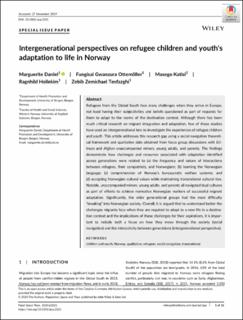| dc.contributor.author | Daniel, Marguerite | |
| dc.contributor.author | Gwanzura Ottemöller, Fungisai Puleng | |
| dc.contributor.author | Katisi, Masego | |
| dc.contributor.author | Hollekim, Ragnhild | |
| dc.contributor.author | Tesfazghi, Zebib Zemichael | |
| dc.date.accessioned | 2021-03-03T14:17:23Z | |
| dc.date.available | 2021-03-03T14:17:23Z | |
| dc.date.created | 2020-05-15T16:50:03Z | |
| dc.date.issued | 2020 | |
| dc.identifier.issn | 1544-8444 | |
| dc.identifier.uri | https://hdl.handle.net/11250/2731487 | |
| dc.description.abstract | Refugees from the Global South face many challenges when they arrive in Europe, not least having their subjectivities and beliefs questioned as part of requests for them to adapt to the norms of the destination context. Although there has been much critical research on migrant integration and adaptation, few of these studies have used an intergenerational lens to investigate the experiences of refugee children and youth. This article addresses this research gap using a social navigation theoretical framework and qualitative data obtained from focus group discussions with Eritrean and Afghan unaccompanied minors, young adults, and parents. The findings demonstrate how challenges and resources associated with adaptation identified across generations were related to (a) the frequency and nature of interactions between refugees, their compatriots, and Norwegians; (b) learning the Norwegian language; (c) comprehension of Norway's bureaucratic welfare systems; and (d) accepting Norwegian cultural values while maintaining transnational cultural ties. Notably, unaccompanied minors, young adults, and parents all navigated dual cultures as part of efforts to achieve normative Norwegian markers of successful migrant adaptation. Significantly, the older generational groups had the most difficulty “breaking” into Norwegian society. Overall, it is argued that to understand better the challenges migrants face when they are required to adapt to a new life in a destination context and the implications of these challenges for their aspirations, it is important to include both a focus on how they move through the society (social navigation) and the interactivity between generations (intergenerational perspective). | en_US |
| dc.language.iso | eng | en_US |
| dc.publisher | Wiley | en_US |
| dc.rights | Navngivelse 4.0 Internasjonal | * |
| dc.rights.uri | http://creativecommons.org/licenses/by/4.0/deed.no | * |
| dc.title | Intergenerational perspectives on refugee children and youth's adaptation to life in Norway | en_US |
| dc.type | Journal article | en_US |
| dc.type | Peer reviewed | en_US |
| dc.description.version | publishedVersion | en_US |
| dc.rights.holder | Copyright 2020 The Authors. | en_US |
| dc.source.articlenumber | e2321 | en_US |
| cristin.ispublished | true | |
| cristin.fulltext | original | |
| cristin.qualitycode | 1 | |
| dc.identifier.doi | 10.1002/psp.2321 | |
| dc.identifier.cristin | 1811268 | |
| dc.source.journal | Population, Space and Place | en_US |
| dc.identifier.citation | Population, Space and Place. 2020, 26 (6), e2321 | en_US |
| dc.source.volume | 26 | en_US |
| dc.source.issue | 6 | en_US |

